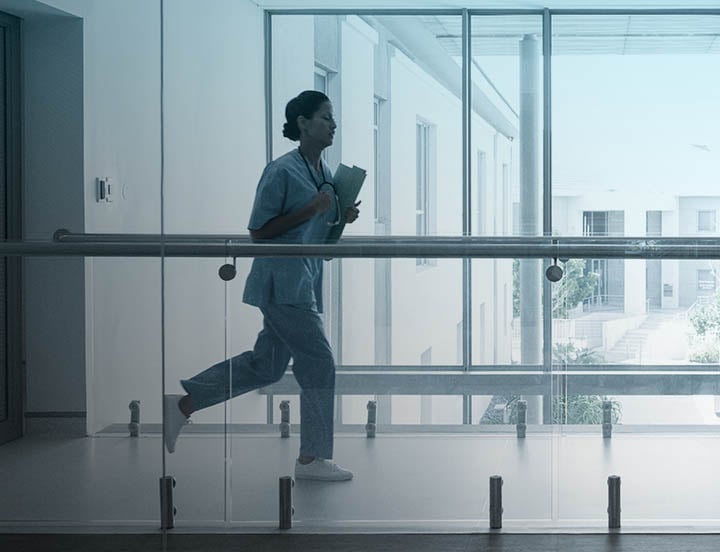At the start of the first UK Covid-19 lockdown, there was a 27% decrease in the number of ED attendances compared to the previous month. Concerns surrounding the coronavirus were causing members of the public to stay away from a hospital, despite needing urgent medical care.
To minimise the virus transmission risk and reduce overcrowding in Emergency Departments (ED), BJSS worked with NHS Digital and NHS X to develop the Emergency Department Digital Integration (EDDI) system.
Developed in under four months, this revolutionary new system is a cloud-based application that is fully integrated with NHS 111 online and NHS 111 telephony. It communicates with NHS 111 through a secure set of APIs (Application Programming Interfaces).
Now, for the first time, EDDI has provided NHS 111 with an interface into Emergency Departments across England, allowing the service to provide patients with a specific ED arrival time based on their clinical need.
Challenge
During the first UK lockdown, it became apparent that members of the public were reluctant to visit their local Emergency Department, despite needing treatment. At the start of the first lockdown, there was a 27% decrease in attendance, a significant decline from the previous month.
Prior to the pandemic, patients with non-emergency cases were encouraged to contact NHS 111. Patients were then triaged, and if urgent treatment was required and ED was the right place to go, they were asked to visit their local ED. There wasn’t the facility to book patients into a specific department or time slot. This increased the risk of overcrowding in waiting rooms, which increased the risk of coronavirus transmission.
As a result, the UK Health Secretary requested that the NHS needed to find a way of reducing the risk of ED overcrowding and needed to do this quickly.
Solution
NHS Digital and NHSX tasked BJSS with developing a system that could reduce ED overcrowding and encourage patients to seek urgent medical care.
Speed of delivery was critical as there was ministerial commitment to have a solution set up across all of England’s emergency departments within a matter of months.
To achieve this, a multi-functional NHS Digital, NHSX and BJSS team adopted an agile delivery approach, rigorous testing, precise scope management, non-functional testing, and collaborative working methods.
This was further complemented by extensive user research with emergency departments across England. The research, conducted by BJSS’ digital design brand, SPARCK, included three parts – exploratory, evaluation and post-live. In total, 49 participants took part in the research, including users such as ED receptionists, service managers and consultants.
In just four months, the team delivered EDDI, the Emergency Department Digital Integration System. This cloud-based application is fully integrated with NHS 111 online and NHS 111 telephony. The system communicates with NHS 111 through a secure set of APIs that meet the NHS’ CareConnect and FHIR standards and Interoperability guidelines.
This vital integration allows NHS 111 to interface with Emergency Departments across England and provide patients with a specific ED arrival time based on their clinical needs. Clinical data is also sent from NHS 111 to the local Emergency Department via EDDI. Emergency Departments can then access this data, view upcoming patient arrival times and update patient arrival statuses.
Benefits
Highly Scalable
EDDI has been engineered with scalability in mind. Hosted on AWS, the system is built on serverless architecture and a Javascript tech stack. Its architecture helps to ease the process of integrating EDDI with other NHS systems, such as the NHS Authentication systems. Initially piloted at Yeovil ED, the technology behind EDDI has enabled the system’s rapid scaling, which now services c140 EDs across England.
Rapid Delivery
From inception to live, the team launched a fully functioning system in just four months. This success centred on the close collaboration between BJSS, NHS Digital and NHSX. The team came together to carry out a meticulous and detailed scope management process, which paved the way for the project delivery. The adoption of agile ways of working allowed the team to deliver the system incrementally through a series of bi-weekly releases. New features and improvements were continuously added throughout, resulting in a fully penetration-tested system that satisfies the AWS Well-Architected framework.
Improved Resource Forecasting
By providing specific urgent care ED arrival times, hospitals across England can allocate an accurate level of resource to cope with demand. EDDI allows NHS 111 operators to share clinical data with Emergency Departments, who can use this data to ensure the most appropriate staff members see patients.
Reduced ED Overcrowding
Crucially, EDDI has given the NHS the capacity for people to book into their Emergency Department for the first time in its history. Patients contacting NHS 111 can now be given a specific ED arrival time at a specific department, attending a quieter, less busy ED waiting room that reduces the risk of coronavirus transmission in emergency departments across England.

